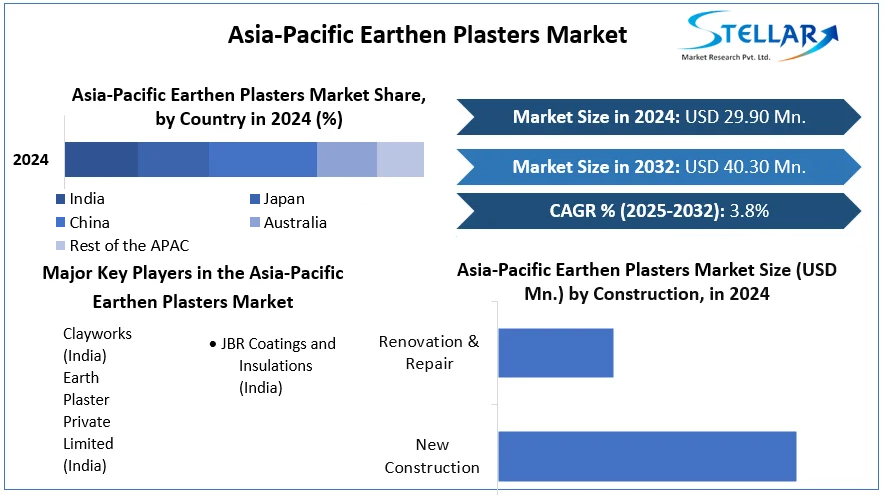Asia-Pacific Earthen Plasters Market Size, Share, Growth Trends, Industry Analysis, Key Players, Investment Opportunities and Forecast (2025-2032)
Asia-Pacific Earthen Plasters Market was valued at USD 29.90 million in 2024. The Asia-Pacific Earthen Plasters Market size is estimated to grow at a CAGR of 3.8 % over the forecast period.
Format : PDF | Report ID : SMR_910
Asia-Pacific Earthen Plasters Market Definition:
Natural oxides and ochre mineral pigments are used to colour earthen plaster, which is created from pure clay and aggregates. The advantages given by clay plasters over natural plasters, as well as the rise in residential, commercial, and industrial building activities throughout the world, are the key drivers of the earthen plaster market. Furthermore, the market for earthen plasters is expected to rise in the next few years due to growing demand for green buildings. "Green constructions are those that are both resource-efficient and ecologically conscious. Clay plaster is natural, inexpensive, and long-lasting. Clay plasters are a good alternative for green buildings because of their characteristics. Furthermore, the rise in demand for green products is forecast to have an impact on the usage of earthenware.
Further, the Asia-Pacific Earthen Plasters Market is segmented by product Type, Application, Construction Type, End User and Geography. On the basis of Type, the Earthen Plasters market is segmented Iron, Calcium, Magnesium, Silicates and Aluminium. Based on the Application, the Earthen Plasters market is segmented under the channels of Walls, Roofs, Masonry and Agriculture. Based on the Construction, the Earthen Plasters market is segmented under the channels of New Construction and Renovation & Repair. Based on the End-User, the Earthen Plasters market is segmented under the channels of Residential and Non-Residential. By geography, the market covers the major countries in Asia Pacific i.e., India, China, Japan, Australia and Rest of Asia Pacific For each segment, the market sizing and forecasts have been done on the basis of value (in USD Million).

To get more Insights: Request Free Sample Report
Asia-Pacific Earthen Plasters Market COVID 19 Insights:
Key Tier I and Tier II vendors compete in the clay putty industry. These providers have manufacturing sites in a variety of Asia-Pacific nations. COVID-19 has had an effect on their activities as well.
The COVID-19 epidemic has had a tremendous impact on the building and construction industry. China is forecast to recover as the pandemic's influence fades. Southeast Asia and India are likely to expand at a rapid pace. The MEA will grow at a gradual rate. In Northeast Asian markets, modest improvements are forecast (excluding China and Japan).
Asia-Pacific Earthen Plasters Market Dynamics:
Green buildings are considered as designs that are environmentally friendly and asset-producing throughout their lifespan. These buildings provide a variety of benefits, including increased energy productivity, manageability, and asset usage efficiency, climate insurance, and resale value. Dirt's characteristics, such as its regularity, toughness, and moderateness, make it an excellent choice for use as a green building material. The growing demand for green products will have a significant influence on the market for earthen plasters.
Earth huts, as they're known, are making a resurgence all over the world. Built with local natural resources such as bamboo, clay, cow dung, stones, and straw by local craftsmen, the structures are designed to use natural light and provide natural cooling, reducing the carbon impact to nearly nil. Many Indian organisations, including Thannal and Vasthukam in Kerala, Made in Earth in Bengaluru, and the Auroville Earth Institute in Auroville, as well as architects like Didi Contractor of Dharamsala, Chennai-based Benny Kuriakose, Kerala-based Eugene Pandala, and Goa-based Gerard da Cunha, are leading the charge to use natural products in construction.
Earthen plasters have a low level of awareness. The knowledge of clay plasters is restricted to a few areas. The market has not undergone significant technological improvements or upgrades, and it is consumed in smaller segments. Due to a lack of awareness about the goods and fewer manufacturers, consumers continue to choose earthen plasters over standard plasters.
Asia-Pacific Earthen Plasters Market Segment Analysis:
By Type: The aluminium category is both the leading and fastest-growing segment of the earthen plaster market, with a positive CAGR in the coming years. The rise of the category is due to the benefits offered by the product. Lowering critical coagulation concentrations, boosting water absorption, clay swelling, and clay dispersion, and decreasing critical coagulation concentrations all help to stabilise clay minerals. Aluminium improves aggregate stability, porosity, hydraulic conductivity, and permeability, as well as the physical properties of soil.
By Application: The wall category held the most market share in 2024, and it is forecast to keep doing so in the following years. The development of the category may be attributed to the advantages of earthen coverings, such as building protection and a wide range of textures. Increased demand for clay coatings in wall applications is forecast to help the market develop.

Asia-Pacific Earthen Plasters Market Key Players Insights:
The market is characterized by the existence of a number of well-known firms. These companies control a large portion of the market, have a wide product portfolio, and have a global presence. In addition, the market comprises small to mid-sized competitors that sell a limited variety of items, some of which are self-publishing organizations.
The market's major companies have a significant impact because most of them have extensive global networks through which they can reach their massive client bases. To drive revenue growth and strengthen their positions in the market, key players in the market, particularly in this region, are focusing on strategic initiatives such as acquisitions, new collection launches, and partnerships.
The objective of the report is to present a comprehensive analysis of the Asia-Pacific Earthen Plasters Market to the stakeholders in the industry. The report provides trends that are most dominant in the Asia-Pacific Earthen Plasters Market and how these trends will influence new business investments and market development throughout the forecast period. The report also aids in the comprehension of the Asia-Pacific Earthen Plasters Market dynamics and competitive structure of the market by analyzing market leaders, market followers, and regional players.
The qualitative and quantitative data provided in the Asia-Pacific Earthen Plasters Market report is to help understand which market segments, regions are expected to grow at higher rates, factors affecting the market, and key opportunity areas, which will drive the industry and market growth through the forecast period. The report also includes the competitive landscape of key players in the industry along with their recent developments in the Asia-Pacific Earthen Plasters Market. The report studies factors such as company size, market share, market growth, revenue, production volume, and profits of the key players in the Asia-Pacific Earthen Plasters Market.
The report provides Porter's Five Force Model, which helps in designing the business strategies in the market. The report helps in identifying how many rivals exist, who they are, and how their product quality is in the Asia-Pacific Earthen Plasters Market. The report also analyses if the Asia-Pacific Earthen Plasters Market is easy for a new player to gain a foothold in the market, do they enter or exit the market regularly, if the market is dominated by a few players, etc.
The report also includes a PESTEL Analysis, which aids in the development of company strategies. Political variables help in figuring out how much a government can influence the Asia-Pacific Earthen Plasters Market. Economic variables aid in the analysis of economic performance drivers that have an impact on the Asia-Pacific Earthen Plasters Market. Understanding the impact of the surrounding environment and the influence of environmental concerns on the Asia-Pacific Earthen Plasters Market is aided by legal factors.
Asia-Pacific Earthen Plasters Market Scope:
|
Asia-Pacific Earthen Plasters Market |
|
|
Market Size in 2024 |
USD 29.90 Mn. |
|
Market Size in 2032 |
USD 40.30 Mn. |
|
CAGR (2025-2032) |
3.8% |
|
Historic Data |
2019-2024 |
|
Base Year |
2024 |
|
Forecast Period |
2025-2032 |
|
Segment Scope |
By Type
|
|
By Application
|
|
|
|
By Construction
|
|
|
By End-User
|
|
Country Scope |
|
Asia-Pacific Earthen Plasters Market KEY PLAYERS:
- Clayworks (India)
- Earth Plaster Private Limited (India)
- JBR Coatings and Insulations (India)
Frequently Asked Questions
Asia Pacific region held the highest share in 2024.
The market size of the Asia-Pacific Earthen Plasters Market by 2032 is expected to reach USD 40.30 Million.
The forecast period for the Asia-Pacific Earthen Plasters Market is 2025-2032.
The market size of the Asia-Pacific Earthen Plasters Market in 2024 was valued at USD 29.90 Million.
1. Asia-Pacific Earthen Plasters Market: Research Methodology
2. Asia-Pacific Earthen Plasters Market Introduction
2.1. Study Assumption and Market Definition
2.2. Scope of the Study
2.3. Executive Summary
3. Asia-Pacific Earthen Plasters Market: Dynamics
3.1. Asia-Pacific Earthen Plasters Market Trends
3.2. Asia-Pacific Earthen Plasters Market Dynamics
3.2.1. Drivers
3.2.2. Restraints
3.2.3. Opportunities
3.2.4. Challenges
3.3. PORTER’s Five Forces Analysis
3.4. PESTLE Analysis
3.5. Technology Roadmap
3.6. Value Chain Analysis
3.7. Regulatory Landscape
4. Asia-Pacific Earthen Plasters Market: Market Size and Forecast by Segmentation (by Value in USD Million and Volume in Kilogram) (2024-2032)
4.1. Asia-Pacific Earthen Plasters Market Size and Forecast, by Type (2024-2032)
4.1.1. Iron
4.1.2. Calcium
4.1.3. Magnesium
4.1.4. Silicates
4.1.5. Aluminum
4.2. Asia-Pacific Earthen Plasters Market Size and Forecast, by Application (2024-2032)
4.2.1. Walls
4.2.2. Roofs
4.2.3. Masonry
4.2.4. Agriculture
4.3. Asia-Pacific Earthen Plasters Market Size and Forecast, by Construction (2024-2032)
4.3.1. New Construction
4.3.2. Renovation & Repair
4.4. Asia-Pacific Earthen Plasters Market Size and Forecast, by End-User (2024-2032)
4.4.1. Residential
4.4.2. Non-Residential
4.5. Asia-Pacific Earthen Plasters Market Size and Forecast, by Country (2024-2032)
4.5.1. China
4.5.2. S Korea
4.5.3. Japan
4.5.4. India
4.5.5. Australia
4.5.6. Indonesia
4.5.7. Malaysia
4.5.8. Vietnam
4.5.9. Taiwan
4.5.10. Rest of Asia Pacific
5. Asia-Pacific Earthen Plasters Market: Competitive Landscape
5.1. SMR Competition Matrix
5.2. Competitive Landscape
5.3. Key Players Benchmarking
5.3.1. Company Name
5.3.2. Product Segment
5.3.3. End-user Segment
5.3.4. Revenue (2024)
5.3.5. Company Locations
5.4. Market Structure
5.4.1. Market Leaders
5.4.2. Market Followers
5.4.3. Emerging Players
5.5. Mergers and Acquisitions Details
6. Company Profile: Key Players
6.1. Clayworks (India)
6.1.1. Company Overview
6.1.2. Business Portfolio
6.1.3. Financial Overview
6.1.4. SWOT Analysis
6.1.5. Strategic Analysis
6.1.6. Recent Developments
6.2. Earth Plaster Private Limited (India)
6.3. JBR Coatings and Insulations (India)
7. Key Findings
8. Industry Recommendations
















